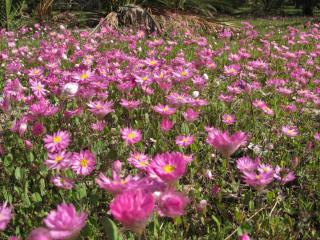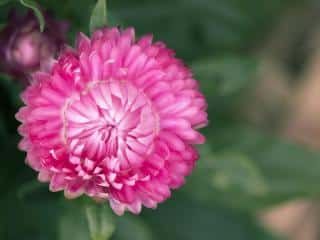

Rhodanthe is a pretty little annual that blooms from spring and until the first frosts, offering magnificent pink inflorescences with a yellow center.
Key Rhodanthe facts
Name – Helipterum roseum
Family – Asteraceae
Type – annual
Height – 20 to 28 inches (30 to 50 cm) depending on variety
Exposure – full sun
Soil: rather light and well drained – Flowering: summer to fall
Very easy to succeed in growing, it also has the advantage of perfectly holding as a dried flower bouquet and thus decorates the inside of our homes in winter.
All there is to know about growing rhodanthe…
In spring, as early as mid-March in mild climates or April in northerly regions.
 In summer, it is always possible to plant your rhodanthe plants purchased in a nursery pot, but it still is most common to sow them directly from seeds.
In summer, it is always possible to plant your rhodanthe plants purchased in a nursery pot, but it still is most common to sow them directly from seeds.
Just like the aster, ordinary soil mixed with a bit of soil mix is perfect, because the soil must drain well.
Very easy to grow, rhodanthe only needs very little care.
If you wish, deadheading is possible – snipping off wilted flowers – in order to spur appearance of new flowers, but new flowers would still bloom even if this isn’t done.
Rhodanthe is sensitive to frost and will only grow back year after year in regions with mild winters. Spontaneous growth from seeds does occur regularly, and some plants that had died off in winter may grow again in spring.
A plant for flower beds, edges or rocky land, rhodanthe is spectacular from spring to fall thanks to its generous blooming which constantly renews itself.
 An easy annual, many diverse varieties and species make for superb blooms in shades of pink and yellow.
An easy annual, many diverse varieties and species make for superb blooms in shades of pink and yellow.
Rhodanthe is also called pink immortal, a name that comes from the fact that its flower when picked and dried holds perfectly all winter long, staying very ornamental all along.
Remember lastly that rhodanthe is one of the easiest flowers to grow, but also is one of those bearing the most flowers from spring to fall.
Rhodanthe fears strong summer heat waves that often lead to the appearance of powdery mildew.
If you are in a region where summer is scorching, it is better to favor partly shaded areas.